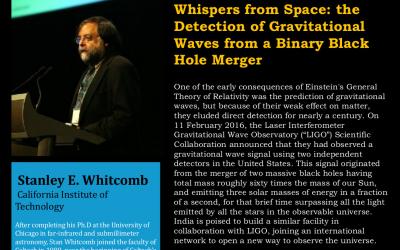One of the early consequences of Einstein's General Theory of Relativity was the prediction of gravitational waves, but because of their weak effect on matter, they eluded direct detection for nearly a century. On 11 February 2016, the Laser Interferometer Gravitational Wave Observatory (“LIGO”) Scientific Collaboration announced that they had observed a gravitational wave signal using two independent detectors in the United States. This signal originated from the merger of two massive black holes having total mass roughly sixty times the mass of our Sun, and emitting three solar masses of energy in a fraction of a second, for that brief time surpassing all the light emitted by all the stars in the observable universe. India is poised to build a similar facility in collaboration with LIGO, joining an international network to open a new way to observe the universe.
This lecture is part of The Future of Gravitational-Wave Astronomy


